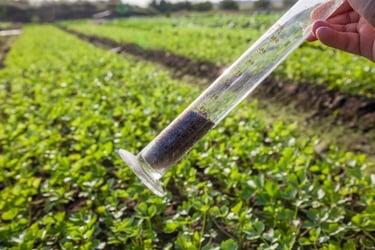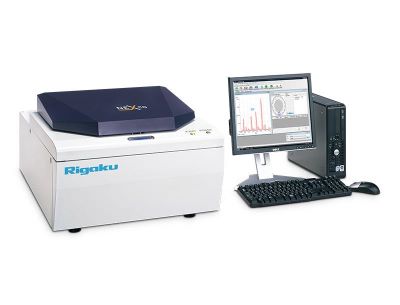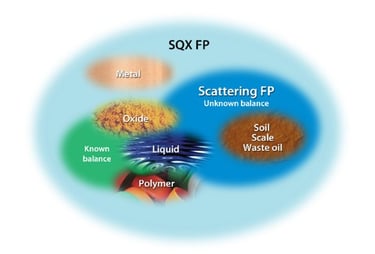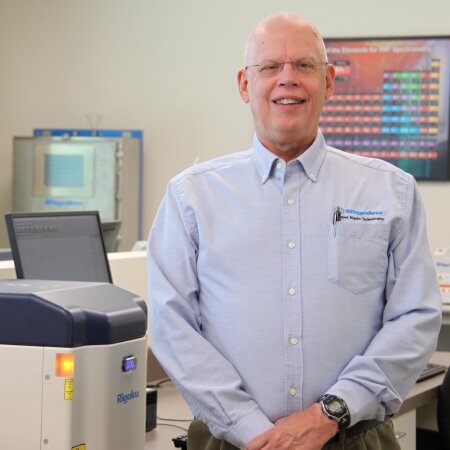Application Note EDXRF1385
Scope
The analysis of agricultural soils and plant materials is demonstrated.
Background
 In the agri-food sector it is important to not only study the soil composition and use of fertilizers, but also the uptake of nutrients and potentially toxic elements within the plants and crops themselves. XRF (X-ray Fluorescence) is an accepted technique in the industry. The Rigaku NEX CG meets the challenges of soil and crop analysis using indirect excitation EDXRF (Energy Dispersive XRF). Secondary targets and polarization give the operator high precision instrumentation with a simple and intuitive software design ideal to meet the demanding trace measurements as well as the measurements of major and minor elements.
In the agri-food sector it is important to not only study the soil composition and use of fertilizers, but also the uptake of nutrients and potentially toxic elements within the plants and crops themselves. XRF (X-ray Fluorescence) is an accepted technique in the industry. The Rigaku NEX CG meets the challenges of soil and crop analysis using indirect excitation EDXRF (Energy Dispersive XRF). Secondary targets and polarization give the operator high precision instrumentation with a simple and intuitive software design ideal to meet the demanding trace measurements as well as the measurements of major and minor elements.
 Model: NEX CG
Model: NEX CG
Samples
Samples were provided by a major European advisory authority for agricultural and food development and testing.
Results: Plant materials
Plant material and crops are mainly organic material with low inorganic levels exhibiting minimal or no mineralogical effects. Three samples of plant material were provided. Two of the samples were used to create a Matching Library, a procedure that is simple for the user to build. The remaining sample was measured as an unknown with results shown here.
| Plant Material Units: ppm (mg/kg) |
|||
| Element | Reference value | NEX CG result | Stat. error |
| Na | 752 | 859 | 121 |
| Mg | 3230 | 3410 | 89 |
| Al | --- | 1250 | 11 |
| Si | --- | 2230 | 6 |
| P | 2580 | 2750 | 5 |
| S | 3070 | 2890 | 5 |
| Cl | --- | 5170 | 3 |
| K | 20500 | 20600 | 54 |
| Ca | 19800 | 19200 | 45 |
| Ti | 14 | 37 | 2 |
| Cr | 1.3 | (1.5) | 0.2 |
| Mn | 44 | 43 | 2 |
| Fe | 528 | 441 | 3 |
| Co | 0.3 | ND | 0.4 |
| Ni | 1.1 | ND | 0.4 |
| Cu | 8 | 7.1 | 0.4 |
| Zn | 20 | 20 | 0.4 |
| As | 0.3 | (0.4) | 0.1 |
| Se | 0.09 | ND | 0.2 |
| Br | --- | 3.2 | 0.1 |
| Rb | --- | 5.6 | 0.1 |
| Sr | 50 | 49 | 0.3 |
| Cd | 0.08 | ND | 1.1 |
| Hg | 0.01 | ND | 0.1 |
| Pb | 0.6 | ND | 0.3 |
ND = Not Detected ( ) = Below Lower Limit of Quantification
Results: Soils
Soils are mainly inorganic with a low organic component. Sodium, magnesium, aluminum, silicon, potassium, calcium and iron occur at high levels. The results below show soil screening using standardless FP without the use of any reference soils.
| Soil Sample 1 Units: ppm (mg/kg) Na, Mg, Al, Si, K, Ca, Fe Units: mass% |
|||
| Element | Reference value | NEX CG result | Stat. error |
| Na | 1.060% | 0.881% | 0.035 |
| Mg | 2.148% | 2.121% | 0.016 |
| Al | 6.331% | 6.834% | 0.008 |
| Si | 25.72% | 25.33% | 0.012 |
| K | 1.691% | 1.907% | 0.009 |
| Ca | 6.204% | 7.749% | 0.014 |
| Fe | 3.345% | 3.564% | 0.003 |
| P | 756 | 852 | 5 |
| S | 195 | 394 | 3 |
| Cl | --- | 89 | 1 |
| Ti | 3839 | 4200 | 23 |
| Cr | 183 | 219 | 4 |
| Mn | 734 | 845 | 10 |
| Ni | 113 | 128 | 3 |
| Cu | 29 | 52 | 1.5 |
| Zn | 79 | 86 | 1.6 |
| As | 9 | 11 | 0.6 |
| Se | 2.5 | 2.3 | 0.3 |
| Br | --- | 7.6 | 0.3 |
| Rb | --- | 112 | 1 |
| Sr | 244 | 284 | 1 |
| Cd | 0.2 | ND | 0.9 |
| Sn | 3.7 | (6.9) | 2.0 |
| Ba | 342 | 435 | 11 |
| Hg | 0.04 | ND | 0.8 |
| Pb | 20 | 26 | 1 |
| Soil Sample 2 Units: ppm (mg/kg) Na, Mg, Al, Si, K, Ca, Fe Units: mass% |
|||
| Element | Reference value | NEX CG result | Stat. error |
| Na | 0.280% | 0.237% | 0.023 |
| Mg | 0.955% | 1.018% | 0.011 |
| Al | 5.455% | 6.355% | 0.007 |
| Si | 19.68% | 18.60% | 0.010 |
| K | 2.298% | 2.560% | 0.009 |
| Ca | 12.89% | 15.28% | 0.021 |
| Fe | 2.499% | 2.601% | 0.004 |
| P | 656 | 721 | 4 |
| S | 1119 | 1550 | 5 |
| Cl | --- | 102 | 1 |
| Ti | 2771 | 3220 | 22 |
| Cr | 54 | 71 | 3 |
| Mn | 322 | 355 | 8 |
| Ni | 23 | 34 | 2 |
| Cu | 16 | 35 | 1.4 |
| Zn | 54 | 61 | 1.5 |
| As | 19 | 20 | 0.7 |
| Se | 2.2 | 2.4 | 0.3 |
| Br | --- | 7.2 | 0.3 |
| Rb | --- | 129 | 1 |
| Sr | 389 | 436 | 2 |
| Cd | 0.3 | ND | 1.0 |
| Sn | 3.9 | (9.0) | 2.0 |
| Ba | 288 | 361 | 10 |
| Hg | 0.02 | ND | 1 |
| Pb | 20 | 28 | 1 |
ND = Not Detected ( ) = Below Lower Limit of Quantification
Fundamental parameters
Rigaku RPF-SQX Fundamental Parameters (FP) and Scattering FP
 The Rigaku RPF-SQX software automatically deconvolutes spectral peaks and models the sample matrix and X-ray absorption and enhancement effects using fundamental XRF equations. The versatile RPF-SQX software is simple to use and offers many ways to craft a matrix model based on the specific material composition. This allows for semi-quantitative analysis without the use of any reference standards, typically returning concentration results on the order of 15-20% relative.
The Rigaku RPF-SQX software automatically deconvolutes spectral peaks and models the sample matrix and X-ray absorption and enhancement effects using fundamental XRF equations. The versatile RPF-SQX software is simple to use and offers many ways to craft a matrix model based on the specific material composition. This allows for semi-quantitative analysis without the use of any reference standards, typically returning concentration results on the order of 15-20% relative.
Scattering FP is the Rigaku technique of using the measurement of the Compton and Thomson (Rayleigh) scatter peaks to gain valuable information about the sample matrix. By comparing the Compton and Thomson scatter peaks, the average atomic number of the sample is calculated and from this the percentage of the sample that cannot be measured (elements H - F) is estimated, improving the quantification of the elements Na – U. Use of Scattering FP is ideal for the analysis of plant materials and soils where the composition of the unmeasurable balance of the sample can change significantly from sample to sample.
Matching Library
The semi-quantitative measurements using RPF-SQX can be further optimized with the use of a Matching Library, as shown in the results of the plant materials. A Matching Library is easily created by the operator using the measurements of one or more assayed reference samples of the same material type. The measurements of these “type standards” are registered in a library specific for the particular material composition of interest and give the FP theoretical equations examples of the actual matrix. Depending on the number of type standards and how closely the type standards resemble the material composition of interest, use of a Matching Library can typically improve accuracy to approximately 5-10% relative.
Soils contain much higher levels of inorganic minerals, especially silicates, and therefore can exhibit noticeable mineralogical effects. Soils can vary widely in composition and unmeasurable balance from area to area and region to region. For this reason reference soils to be used as type standards in a Matching Library must come from the same area as the unknown soil samples to be measured in order to ensure optimum accuracy using FP.
The highest degree of accuracy requires the use of matrix-matched empirical regression calibration. For the full characterization of plant materials and soils this may require on the order of a hundred or more calibration standards that model all the variations that may occur, and therefore FP is preferred in the industry rather than empirical calibration.
Conclusion
Given homogenous samples the Rigaku NEX CG yields excellent performance for the elemental analysis of plant materials and soils. If desired, FP standardless semi-quantification can be improved with Matching Libraries based on one or more assayed type standards of the particular material type. The NEX CG software is powerful and flexible, yet simple and intuitive to operate. These features make the NEX CG an ideal EDXRF tool for screening and characterization of plant materials and soils.

